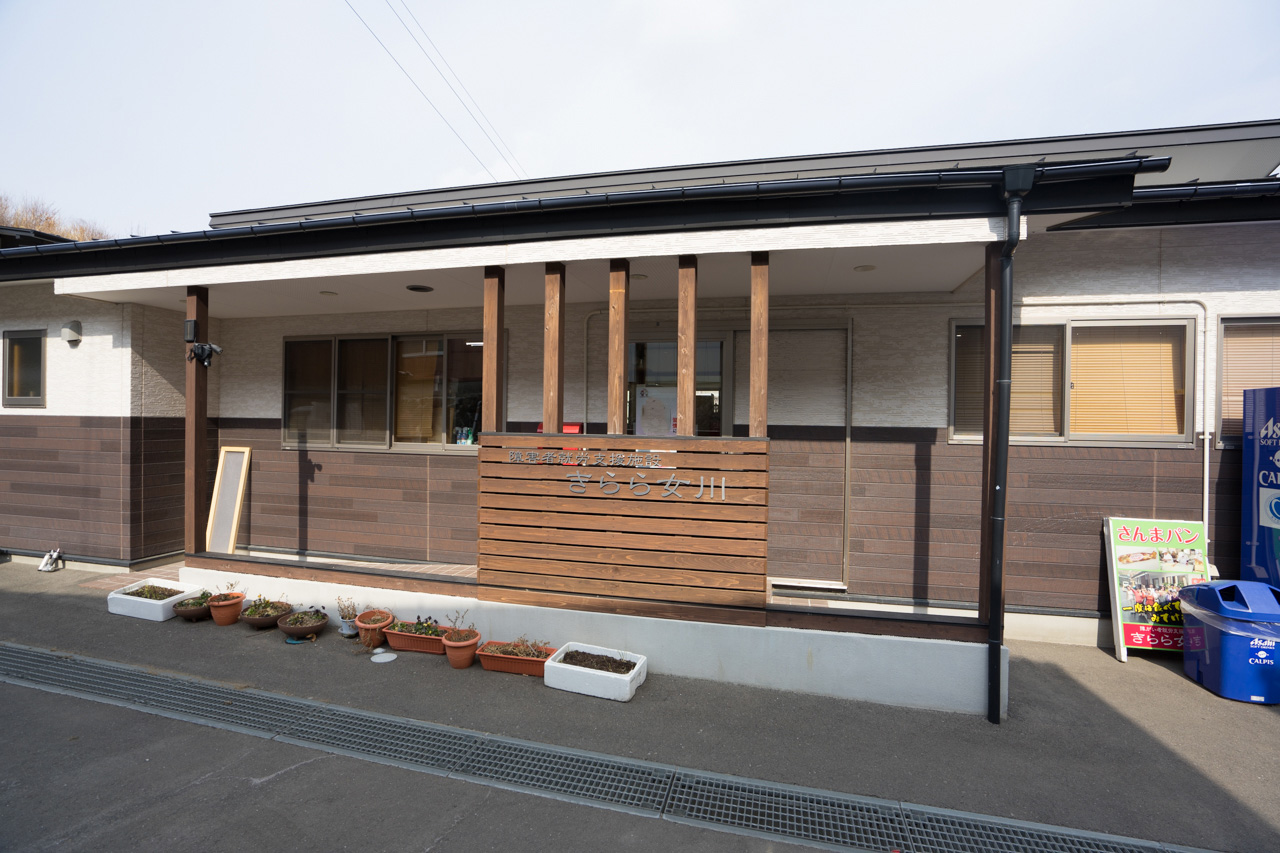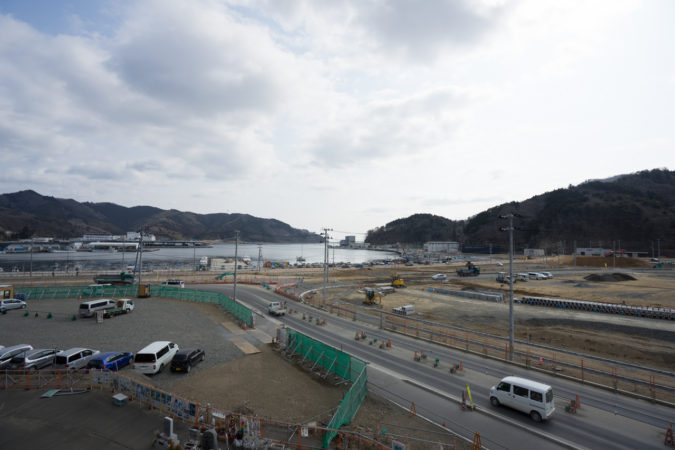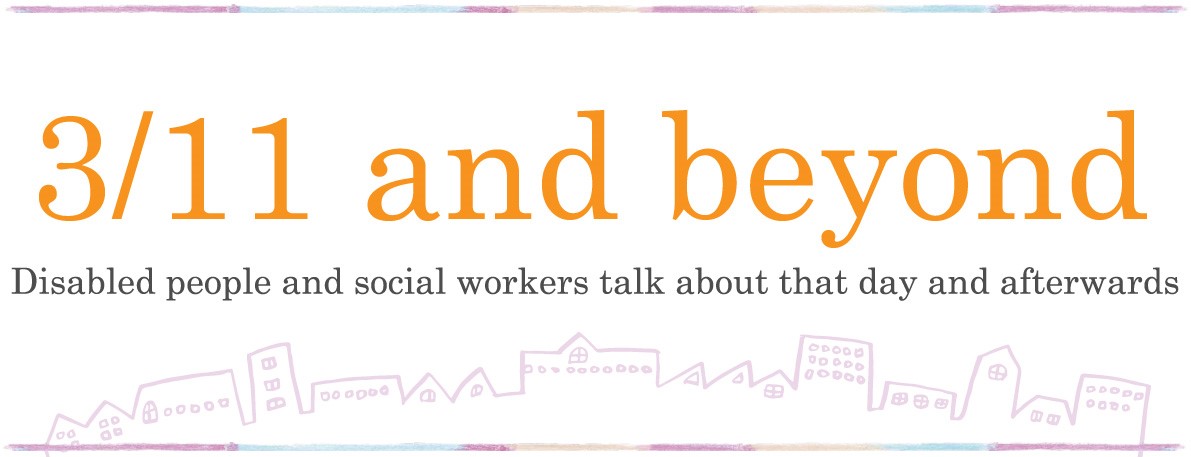 お話:特定非営利活動法人 きらら女川 所長 松原千晶さん
お話:特定非営利活動法人 きらら女川 所長 松原千晶さんNPO Kirara Onagawa
 お話:特定非営利活動法人 きらら女川 所長 松原千晶さん
お話:特定非営利活動法人 きらら女川 所長 松原千晶さんSituation at the time of the disaster
What happened at the time of the disaster on March 11?
We were to expand our activities at the vocational support center for the disabled and it was the day we were moving to our new location. We started in the morning and had finished moving most of large items by the time.
Our workshop started the year before. As there was no place for people with disabilities to obtain vocational training in the area, demands for our place grew rapidly so we decided relocation to somewhere closer to city center. However, we lost by the tsunami on that day both Kirara Onagawa’s original place, which was very close to the coast and where our trainees used to work, and our new location.
Out of business for 2 years
When did you start considering the reopening of the workshop?
We couldn’t think about anything other than confirming our trainees’ safety in the days following the disaster. We moved from there to think about the future of the trainees. We had to face our challenge of “living together” and it was not yet time to talk about reopening the facility. But of course we weren’t giving up. None of us thought about leaving things we had built in the past.
You can’t abandon your trainees, right?
I believe that not doing what we can do constitutes abandoning the trainees. Our continuous efforts to do what we could have led us to where we are now, I think.
I heard that it took two years before you reopened the workshop.
Yes. The experiences in that disaster differ person to person, and it is not possible to summarize them into one story, right? It took two years for us to reopen our workshop, but yet it was the first building that had been built in Onagawa after the disaster. That tells how badly the town was damaged.
Developing products
Kirara Onagawa is famous for its “Sanma Pan (Bread with saury fish)”. Did that played a major role in your business?
The bread was a part of our products. Our main product is “Okara karintou (fried-dough cookies made with soybean curd residue). We received a lot of orders from people around Japan for this product, and that helped us tremendously.
Doing business with just one product to sell is very unstable. Having multiple items to sell can make the entity stronger. It is not easy but makes us more flexible and stable.
Hardship experienced for reopening
How many staff members do you currently have?
We are five including me. We also have three part timers for shop keeping, driving and serving meals. Two staff members quitted last year. Part timers are helping with the work for those positions but the work volume is quite big and it’s not easy to handle. Fulltime staff is putting extraordinary efforts to complete these tasks. What they do is really amazing. I really respect them.
With some new and nice buildings, it looks reconstruction work in this area has accomplished quite a lot. What were the things you felt most difficult along the way?
The hardest part was the day of the disaster itself. After that, there was no choice we had to push ourselves forward. The most impressive thing was the gap between the places that were affected by the disaster and those that weren’t. I came here from Tottori prefecture before the disaster to help establish a vocational support center for the disabled in the town of Onagawa. My plan was to stay for a year or two to start up and help the project run smoothly before going back to Tottori. There came that disaster.
It actually took two years to restart the workshop in Onagawa. I really did everything possible to bring it back. We would have lost our clients if we had just waited things to happen. We had to restart production lines and supply them to our clients as soon as possible. We couldn’t lose their order to bring our business back on track. However, there was no way we could start operating in Onagawa for some time because of the severity of damage caused by the disaster. I decided, therefore, to take advantage of my connections in Tottori and open a workshop there, and started supplying items in June 2011. I was honored to welcome people with disabilities who were willing to work with me in Tottori as well. Some people complained for the volume of work that they had not experienced before. I travelled between Onagawa and Tottori back and forth keeping in myself the reopening of the workshop in Onagawa as the goal. We didn’t even have a place to gather in Onagawa, so I met with the trainees once a month in a restaurant in shopping mall in the nearby city of Ishinomaki to update ourselves. Those people lost their houses, places to go, and jobs. I kept the phrase “we are busy in Tottori” in myself when I met with them. I felt very sorry that I had to make them wait, and told them I was trying thing little by little. As the time finally came for us to restart what we were initiating in Onagawa, I had to come here. People with disabilities and their families I was working with in Tottori asked me what would happen with them and asked me not to leave Tottori. That was when I felt a big gap between the areas affected by the disaster and the places that were not. I could only explain to them that people were still suffering from the damages caused by the disaster. Of course the workshop in Tottori is still going in parallel and a lot of people work there.
Restarting
You restarted the workshop in Onagawa two years after the disaster. How were the people working there at the beginning?
When the reopening of the workshop was decided, people finally opened their mind and told frankly “I have been waiting all the time” or “It’s been so long.” Yes, they were holding their true feelings. Some were even worried how I was doing.
They were filled of hope, and their happiness was far beyond any words could express, I believe.
However, our place was the first built structure in town after the disaster, and many residents and companies were still struggling in rebuilding their lives and premises. I was hesitant to openly celebrate our achievement.
You felt some kind of constraint because there were gaps between who had basic necessities and who didn’t, and your place was the first building to have been built after the disaster.
I myself felt very difficult not to have place to go or work to do while I was in the evacuation center. I wanted to keep my work all my life if possible. I imagine our trainees who had worked at the workshop felt the same.
As we restarted, trainees felt so happy about the simple fact they had work to do, and they enjoyed it so much. They committed to the work and completed the tasks very quick. They are still very eager to work and they even look for more thing to do.
What do you think is keeping the motivation of both staff and the trainees?
It’s the fact that they have work to do. The most difficult part of vocational support projects is to create jobs, but it is the challenge staff members have to take. As the name “vocational support” clearly suggests, we always have to face this issue.
For future development

Do you still feel you are putting all your energy in the reconstruction, Ms. Matsubara?
I don’t think I’m putting all my energy, but I think things will go backward if we stop. My goal was to establish in Onagawa a place for people with disabilities to be able to work, and help it run smoothly. From this particular point of view, I feel I could achieve something.
Considering the characteristics of the area, I believe we don’t need to expand the capacity of this workshop in Onagawa.
However, I am always considering expanding the business and tasks. They are related to work flows and economic aspects such as efficiency of the work, their improvements, about making better quality products, and the way how we could raise the payment.
Not doing things frantically but calculating for better outcome and trying with helps of people around us; that is what we could do. If things don’t work out, we find ways to promptly withdraw. We need to secure not to accumulate financial loss, that’s the bottom line I think.
We have been doing in this way by trying different methods, I suppose.
What is Kirara Onagawa trying to do in view of its future?
It is to hand our visions down to next generations. There are two key points I need to convey to staff members. Our role of course is to support persons with disabilities for their employment.
Firstly, we need to form sense of due responsibility and skills to check our own work. It’s a plain standard for private companies.
Second point is not to spare any effort to help improve trainees’ skills.
I will try to convey these to the staff, and I hope they do the same to future generations. Expanding the things what trainees can do is beneficial both for them and for the workshop.
We, staff have to show how to do first. With efforts of the trainees themselves and the perseverance of the staff, they will acquire the skills. It would be ideal that one day a trainee pushes staff’s hands away and says “I don’t need your help anymore.”

